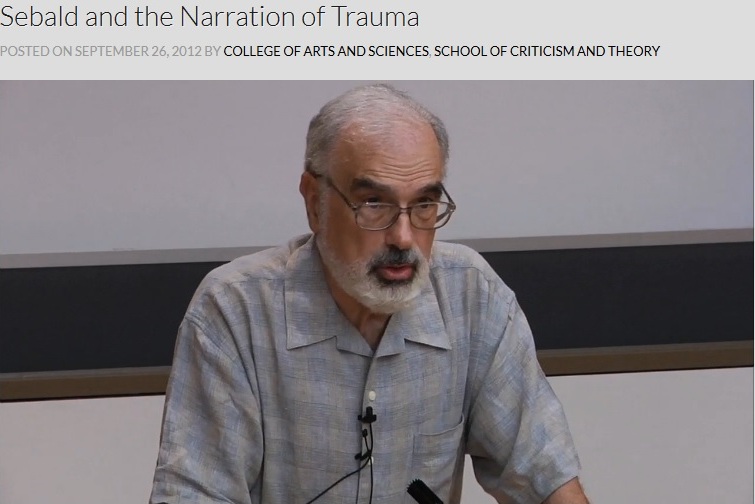
The phrase “Ariadne’s thread” usually refers to the process of solving a maze or other complex problem through a physical trace (the mythical ball of thread) or a some method of recording and verifying one’s options and decisions. In Philippa Comber’s new memoir Ariadne’s Thread: In Memory of W.G. Sebald, the thread ultimately leads us back into the maze that was W.G. Sebald. In 1980, Comber, a young English-born psychotherapist living in Berlin whose marriage was “foundering,” moved to Norwich for a new job. In August 1981 she joined up with a small group of friends and others to see Roman Polanski’s movie Tess. Among the group was Sebald, then in his mid-thirties and a lecturer at the University of East Anglia. Comber and Sebald hit it off.
They had common interests in European literature and living “in exile,” as she puts it. Sebald began calling her on the telephone and calling on her at home, bringing vegetables and flowers and offering assistance with the renovation of her house. In the first three months they saw each other some ten times and it began to feel like “an old-fashioned courtship” to Comber. But the “courtship” stalled, leaving Comber puzzled over her new friend. When her father died and she asked Sebald over the telephone to visit her, he declined – he had to walk the dog, he explained.
In the summer of 1982, Sebald surprised Comber by asking if she would become his psychotherapist. But she put him off, afraid, in part, that a professional relationship would foreclose any remaining chance for the more personal one for which she still had hopes. Then, in 1985, a new man entered Comber’s life and communications with Sebald ended for three years, resuming in the summer of 1988. In December 1996, Comber took a new position that required her to move to Aberdeen, once again causing her to lose touch with Sebald, this time for the remainder of the decade. They finally resume communicating shortly before Sebald’s death in September 2001.
This, then, is the skeltal structure of the fascinating friendship between Philippa Comber and W.G. Sebald, which Comber enchantingly tells in her memoir. Aided by her diaries, Comber is able to share intriguing facts and her own analyst’s insights into Sebald’s mind at a crucial time in his career. When the two first met, he he had published only his two early academic volumes of literary criticism and some articles. But he was already trying to find another outlet for his writing and he shared with Comber a screenplay he had written about Kant. Later on, he shared with her a section of what would become, in 1988, his book-length poem Nach der Natur. Ariadne’s Memoir is full of enticing bits and pieces, such as the fact that she introduced Sebald to Ulrich Rauff, who would later become Director of the Deutsche Literaurarchiv Marbach, the man who would be responsible for acquiring Sebald’s literary papers. It was Comber who suggested Sebald read Sir Thomas Browne’s Urne Buriall. And in July 1982, she tells us,Sebald barely escaped death in an automobile accident that was strikingly similar to the one that did kill him in 2001.
But perhaps more intriguing are Comber’s many thoughts about Sebald the man. She ultimately came to believe they were both “companions-in-pain” and she sensed “he’s deeply afraid of his physicality…at war with his body.” She also decided that he “took a very dark view indeed of the redeeming power of heterosexual love,” which would seem to provide some support for the thesis underlying Helen Finch’s recent book Sebald’s Bachelors: Queer Resistance and the Unconforming Life. In the end, however, Comber remains coy and respectful about Sebald’s private life, never once even mentioning that Sebald had been married since 1967.
Comber’s memoir is not solely about Sebald. It also traces her own fascinating life and the very interesting circles in which she moved, which included a life-long friendship with Christine Heisenberg, the daughter of Werner Heisenberg, and Christine’s husband-to-be Frido Mann (grandson of Thomas Mann). Written with grace and wisdom, Ariadne’s Thread gives us a glimpse of Sebald unseen to date. It also serves as a reminder of how important it will be when one day we have a first-rate full biography of Sebald.
Ariadne’s Thread is the inaugural publication of Propolis Books, the new non-fiction publishing imprint of Norwich’s bookstore The Book Hive. The book will be released on September 5 and there will be a launch party September 18. Comber is one of the presenters at the upcoming colloquium “W.G. Sebald: Littérature et Éthique Documentaire” at the Centre Culturel International de Cerisy, September 3-10, 2014.






